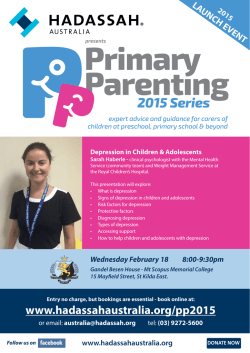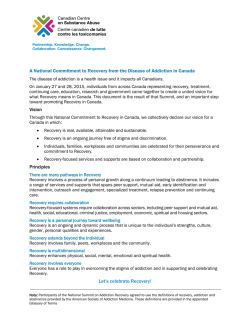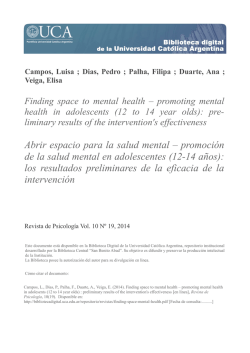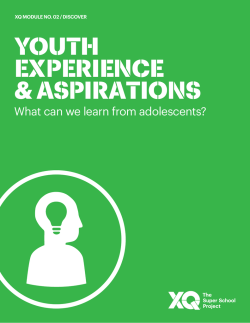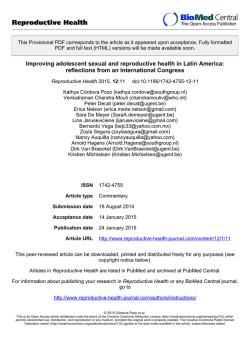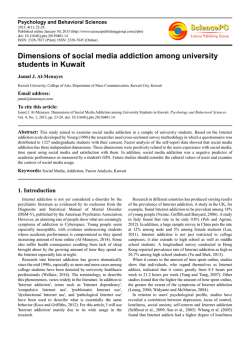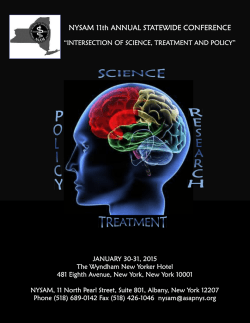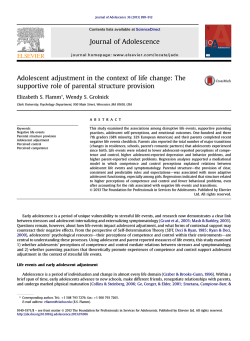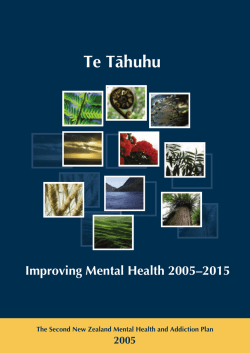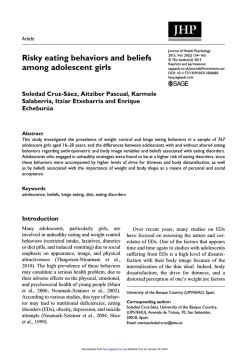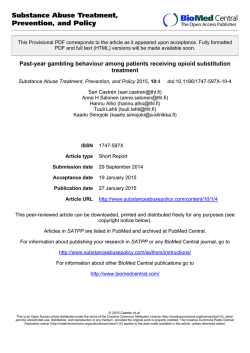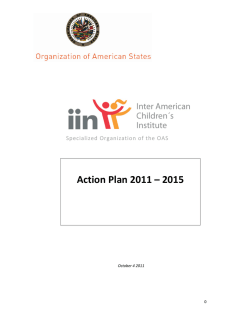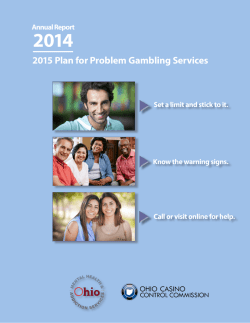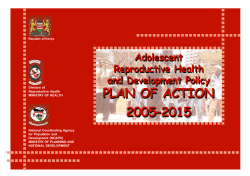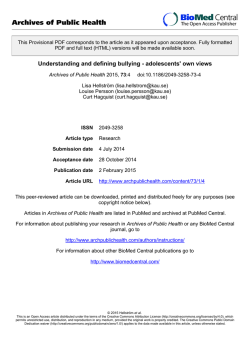
nestle naturnes frutas variadas ( 2 x 130g)
original adicciones vol. 26, nº 3 · 2014 Duration of Internet use and adverse psychosocial effects among European adolescents Tiempo de uso de Internet y efectos psicosociales adversos en adolescentes europeos Roberto Secades-Villa*, Amador Calafat**, José Ramón Fernández-Hermida*, Montse Juan**, Mariangels Duch**, Eva Skärstrand***, Elisardo Becoña****, Sanela Talic***** *Department of Psychology, University of Oviedo, Spain; **European Institute of Studies on Prevention (Irefrea), Spain; ***Stockholm Centre for Psychiatric Research and Education, Sweden; ****Deparment of Clinical Psychology and Psychobiology, University of Santiago de Compostela, Spain; *****Institute for Research and Development (UTRIP). Slovenia. Resumen Abstract A pesar de las importantes contribuciones de los estudios realizados Despite the significant contributions from previous studies about the sobre la prevalencia del uso problemático de Internet (PIU) entre prevalence of problematic Internet use (PIU) among adolescents in los adolescentes europeos, sigue existiendo dudas importantes Europe, important questions remain regarding adverse consequences con respecto a las consecuencias adversas del PIU. El objetivo de of PIU. This study aims to assess the relation between duration of este estudio fue evaluar la relación entre la duración del uso de Internet use and adverse psychosocial effects among adolescents from Internet y los efectos psicosociales adversos en adolescentes de six European countries. The final sample included 7,351 adolescents seis países europeos. La muestra final estuvo compuesta por 7.351 (50.8% male and 49.2% female; mean age: 14.6±1.90) recruited from adolescentes (50,8 % varones y 49,2 % mujeres, edad media: 14,6 randomly selected schools within the six study sites. Results showed años ± 1,90) reclutados en escuelas seleccionadas al azar dentro de that 12.9% of adolescents used Internet more than 20 hours per week. los seis países del estudio. Los resultados mostraron que el 12,9% de There was a significant relationship between duration of Internet use los adolescentes utilizaba Internet más de 20 horas a la semana. Se and frequency of alcohol, tobacco, cannabis and other illegal drug encontró una relación estadísticamente significativa entre la duración use. Duration of Internet use is also significantly associated with school del uso de Internet y la frecuencia de uso de alcohol, tabaco, cannabis problems, with use of slot machines and with other psychosocial y otras drogas ilegales. La duración del uso de Internet también se problems. These findings highlight the need to strengthen preventive asoció significativamente con problemas escolares, con el uso de efforts for reducing PIU and related consequences among adolescents. las máquinas tragaperras y con otros problemas psicosociales. Estos Key Words: Internet, adolescents, psychosocial problems. resultados ponen de relieve la necesidad de fortalecer los esfuerzos en prevención para reducir el uso problemático de Internet y las consecuencias relacionadas entre los adolescentes. Palabras Clave: Internet, adolescentes, problemas psicosociales. Recibido: Noviembre 2013; Aceptado: Febrero 2014 Enviar correspondencia a: Roberto Secades-Villa. Department of Psychology. University of Oviedo. Plaza Feijoo s/n 33003 – Oviedo – Spain. E-mail: [email protected] ADICCIONES, 2014 · VOL. 26 NÚM. 3 · PÁGS. 247-253 247 Duration of Internet use and adverse psychosocial effects among European adolescents U sing the Internet has become one of the most popular leisure-time activities in Western societies. Particularly among adolescents, the Internet is observed to be increasingly adopted as a readily accessible means for information retrieval, entertainment, and socialization (Kormas, Critselis, Janikian, Kafetzis, & Tsitsika, 2011). For the majority of Internet users, the World Wide Web represents a tremendous wellspring of opportunity that enhances well-being. However, for some people the Internet can lead to psychosocial problems, including mental disorders (Aboujaoude, 2010). Due to the lack of consensus on diagnostic criteria and the dearth of large epidemiological studies, the prevalence of PIU in the adolescent population has not been well established. The results can vary widely and are difficult to compare, due to differences in Internet access, recruitment methodology, the exact age bracket studied, and the definitions utilized (Aboujaoude, 2010).Considering only relatively large and offline studies, research has yielded prevalence estimates ranging between 2% and 11% (Cao & Su, 2007; Ghassemzadeh, Shahraray, & Moradi, 2008; Johansson & Gotestam, 2004; Kim et al., 2006; Park, Kim, & Cho, 2008; Siomos, Dafouli, Braimiotis, Mouzas, & Angelopoulos, 2008).In particular, among European adolescents, the prevalence of PIU has been observed to range between 2% and 15.1% (Durkee et al., 2012; Johansson & Gotestam, 2004; Niemz, Griffiths, & Banyard, 2005; Pallanti, Bernardi, & Quercioli, 2006; Sasmaz et al., 2013; Siomos et al., 2008). PIU in adolescence has been associated with a wide range of adverse psychosocial and mental health conditions such as attention-deficit/hyperactivity disorder (ADHD) (Yoo et al., 2004), psychosomatic symptoms (Cao, Sun, Wan, Hao, & Tao, 2011; Jenaro, Flores, Gómez-Vela, González-Gil, & Caballo, 2007), inappropriate dietary behavior and poor diet quality (Kim et al., 2010), interpersonal problems (Seo, Kang, & Yom, 2009), aggressive behaviors (Ko, Yen, Yen, et al., 2008) or depressive symptoms (Morrison & Gore, 2012). Despite the significant contributions from previous studies, important questions remain regarding adverse consequences of PIU in adolescence. For example, findings from previous studies have often been constrained by their focus on specific geographic locations or examined a limited number of psychosocial variables. No published study has examined consequences of PIU in adolescence usually associated with addiction, such as multiple substance use or impairment in family and social activity. The vast majority of studies were conducted in Asia, most of them in China and very few studies have been conducted in Europe. Thus, more research needs to be performed in other regions of the world for eventual cross-cultural comparisons (Carli et al., 2011). We sought to address these gaps in knowledge by identifying the relation between Internet use and psychosocial problems by drawing on data from community samples from six regions in Europe. Due that the duration of Internet use has a close relationship with Internet addiction and PIU, and the longer the Internet using time the more risk there is to be addicted (Cao et al., 2011; Carli et al., 2011; Durkee et al., 2012; Grohol, 1999), we used duration of Internet use as a proxy of PIU. The specific goals of the present study were to assess the association between duration of Internet use and: 1) use of tobacco, alcohol and illegal drugs, 2) school problems, 3) use of slot machines; and 4) other problematic behaviors such as stop playing sports/hobbies, injured after drinking, trouble with police, have family problems, sexually transmitted diseases, lost friends and have gained weight. Methods Study design and participants A survey was carried out between October 2010 and February 2011 in sixty-nine middle schools from six European regions (23.9% from Coimbra in Portugal, 13% from Ljubljana in Slovenia, 22.7% from Mallorca Island in Spain, 10.8% from Merseyside in UK, 15.9% from Prague in Czech Republic, and 13.6% from Stockholm in Sweden). For all countries we used a common protocol to select the sample, procedures to be followed in the survey, collection of incidents, management and delivery of questionnaires to be included in the database. We used a stratified and incidental school sample taking into account if it was a public or private school, the size and the location of the school, according with the real distribution of schools in each region. There could be only one classroom per school year for each school. The procedure for obtaining consent from participants differs in each country. In total, 7,701 children’s surveys were included in the analysis. Approximately 350 were excluded for reasons including non-completion of major sections (substance use) and illegibility of responses. A total of 50.8% of the participants were boys and 49.2% were girls. Mean age of the sample was 14.6 years (s = 1.90; range: 11-19 years). Measures A team of four people, specially trained for this study, was sent to each school to talk to the participants about the aims of the study and the confidentiality of the data. All students filled out an anonymous questionnaire in their classrooms and during school time. Duration of Internet use was determined by asking respondents about “approximately, how much time are you using Internet at home each week (in hours)”. For evaluating the Internet sited use we included the following predefined and not exclusive categories: social networking, chat room use, downloading movies, music, watching TV, shopping, email, gaming and school work. Extensive questions covered drug use. For the evaluation of the adolescents’ alcohol use the item used was: “How frequently do you drink alcohol?”, and the response options being: “I have never drank alcohol”, “Less than once a month”, “Once a month”, “Once a week”, “2-4 times a week” and “Every day, ADICCIONES, 2014 · VOL. 26 NÚM. 3 248 Roberto Secades-Villa, Amador Calafat, José Ramón Fernández-Hermida, Montse Juan, Mariangels Duch, Eva Skärstrand, Elisardo Becoña, Sanela Talic or almost”. Frequency of drunkenness was determining by asking individuals: How many times have you been drunk in the last month?” For the assessment of smoking we used the item: “Read the following statements and tick the box for that which best describes you: I have never smoked, I have only tried smoking once, I have smoked once or twice in the past but now I don’t, I smoke cigarettes but not more than one a week, I smoke between one and six cigarettes a week, In general I smoke more than six cigarettes a week”. For the evaluation of cannabis use we asked: “Have you ever used cannabis?”, the response options being: “No”, “Yes, at some time in my life”, “Yes, in the last 12 months” and “Yes, in the last 30 days”. For the evaluation of illegal drug use we used a dichotomous response question: “Have you ever used illegal drugs (cocaine, ecstasy, amphetamine, heroin, others..)?”. The school variables have been classified into three different dimensions: Performance (“It is difficult to pay attention in class”, “I forget things” and “I have trouble keeping up with homework”), Absenteeism (“I missed class because I feel sick”, “I go to school but sometimes I miss some classes”, “Sometimes I’m not going to school because I do not want to go”, and “Sometimes I’m not going to school because my parents/caregivers not let me go to school”) and Satisfaction(“I am happy to be at school/college/university” and “I feel safe at school/college/university”). For the evaluation of other different psychosocial problems the question used was: “Have you experienced any of these problems during the past six months?” The items were:, ”injured after drinking”, “having trouble with the police”, “having family problems”, “regret having had sex with someone, “sexually transmitted diseases”, “have lost friends, “put on weight”. Responses were categorized as “yes” or “no”. Finally, slot machines use was determined by asking respondents about “how often do you play on slot machines”. Response options were: “never”, “a few times a year”, “once or twice a month”, “at least once a month” and “almost every day”. Data analyses Various descriptive and frequency analyses in relation to participants’ characteristics were carried out. The relations- hip between different variables measured by the questionnaire and frequency of Internet use were analyzed using chi-squared tests. Effect sizes of principal comparisons were calculated using phi (Ф) for χ2 tests, in order to maintain values for small, medium and large effects (.10, .30 and .50). Confidence level was 95%, and the statistical package used was the SPSS-15. Results Duration of Internet use and Internet sited used Ninety-four percent of adolescents use the Internet at home. Rates of Internet use were as follows: 3.0% of adolescents never used Internet, 36.2% used Internet between 1 and 5 hours per week; 29.3% used Internet between 6 and 10 hours per week; 18.7% used Internet between 11 and 20 hours per week and 12.9% used Internet more than 20 hours per week. Seventy-five percent of adolescents used social networking (e.g. Facebook), 28.6% chat rooms, 62.25% downloading movies, music, etc., 28.8% for watching TV, 15.2% for shopping, 53.8% to email, 41.5% for gaming and 64.8% for school work. Fifty six percent of respondents reported that parents do not limit the time they can use the Internet. Duration of Internet use and drug use There is a statistically significant relationship (p= .000) between duration of Internet use and alcohol use (Table 1). Among adolescents who use the Internet less time (1-5 hours) the frequency of alcohol consumption is lower than expected. The opposite trend occurs with adolescents who use the Internet more than 20 hours a week. Chi-square tests also showed a significant positive relationship between duration of Internet use and tobacco use (p= .000). Adolescents who use the Internet more time per week tend to use more cannabis (p= .000) and other illegal drugs (p= .000). Specifically, among those who use the Internet more than 20 hours per week are twice more likely to be cannabis users than expected by chance. In contrast, among those who use the Internet between 1-5 hours are half as many likely to be regular users than expected by chance (Table 1). Table 1 Relationship between Internet use and drug use Drug use Chi square* N Df P Effect size (Ф) Alcohol use 411.273 6678 24 .000 .248 Frequency of drunkenness 115.880 3594 80 .005 .180 Tobacco use 220.509 7439 20 .000 .172 Cannabis use 186.707 7294 12 .000 .160 Other illegal drugs 108.096 7556 4 .000 .120 * With Yates continuity correction ADICCIONES, 2014 · VOL. 26 NÚM. 3 249 Duration of Internet use and adverse psychosocial effects among European adolescents Table 2 Relationship between Internet use and school factors School factors Chi square* N Df P Effect size (Ф) Problem paying attention in class 233.749 7565 16 .000 .176 Forget things 123.979 7552 12 .000 .128 Trouble keeping up with homework 129.406 7528 12 .000 .131 Missed class because sickness 68.014 7524 12 .000 .095 Sometimes miss some classes 162.507 7535 12 .000 .147 Sometimes not going to school because do not want to go 185.773 7539 12 .000 .157 Sometimes not going to school because my parents/caregivers let me not go to school 145.391 7544 12 .000 .139 Happy to be at school 140.408 7529 12 .000 .137 Feel safe at school 127.848 7481 12 .000 .131 * With Yates continuity correction Table 3 Relationship between Internet use and interpersonal and psychosocial problems Psychosocial problems Chi square* N Df P Effect size (Ф) Injured after alcohol 109.441 7557 4 .000 .120 Trouble with police 95.049 7556 4 .000 .112 Family problems 47.066 7554 4 .000 .79 Had regretted sex 63.761 7546 4 .000 .092 Losing friends 41.925 7538 4 .000 .075 Put on weight 22.685 7503 4 .000 .055 Sexually transmitted diseases 115.510 7544 4 .000 .124 * With Yates continuity correction Duration of Internet use and school factors Duration of Internet use and use of slot machines There is a significant relationship between duration of Internet use and school problems (p= .000) (Table 2). In all cases, adolescents using more than 20 hours of Internet per week have a lower school performance and school satisfaction, and higher rates of absenteeism than expected by chance. There is a statistically significant relationship between duration of Internet use and the frequency of playing on slot machines χ2 (16, N = 7411) = 113.100, p= .000; Ф= .124. We also performed the same analysis but collapsing the variable ‘frequency slot game’ in two categories: 0 (never) and 1 (other cases, from ‘a few times a year’ to ‘almost every day’). The results also show a statistically significant relationship between the two variables χ2 (4, N = 7411) = 70.346, p= .000; Ф= .097. Duration of Internet use and interpersonal and psychosocial problems There are statistically significant relationships between duration of Internet use and the following problems: injured after drinking, trouble with police, family problems, regretted having sex with someone, losing friends, put on weight and have sexually transmitted diseases (Table 3). In all cases, the likelihood of such problems is higher than expected by chance among teens who use the Internet more than 20 hours per week. Conversely, the likelihood of problems is lower than expected by chance among those who use the Internet between 1-5 hours (Table 3). Discussion To our knowledge, this is the first study to examine the relation between duration of Internet use and psychosocial problems in an adolescent community sample from several regions in Europe. The study findings suggest that adolescents who use the Internet for longer are more likely to concomitantly exhibit psychosocial problems. Specifically, ADICCIONES, 2014 · VOL. 26 NÚM. 3 250 Roberto Secades-Villa, Amador Calafat, José Ramón Fernández-Hermida, Montse Juan, Mariangels Duch, Eva Skärstrand, Elisardo Becoña, Sanela Talic we emphasized four major results: 1) A high percentage of the study population is at risk of PIU, as the number of hours per week using the Internet is very high; 2) adolescents who use the Internet excessively compared to their peers are at greater risk to use drugs; 3) adolescents who use Internet for longer have poorer school performance and miss more school classes; 4) the odds of psychosocial problems are greater among adolescents who use the Internet more than 20 hours per week; and 5) the frequency of gambling among those who use the Internet more hours is greater than among adolescents who use Internet less time. In line with other studies, our results showed that excessive Internet use is very high. There is increasing evidence that PIU among adolescents is emerging due to easy access to the Internet (Gómez Salgado, Rial Boubeta, Braña Tobío, & Varela Mallou, 2014). Adolescents may be particularly vulnerable to the development of PIU and addictive behavioral patterns in general (Griffiths & Wood, 2000; Pallanti et al., 2006; Puerta-Cortés, & Carbonell, 2014; van den Eijnden, Spijkerman, Vermulst, van Rooij, & Engels, 2010). Consistent with findings from previous studies (Fisoun, Floros, Siomos, Geroukalis, & Navridis, 2012; Kim, 2012; Lam, Peng, Mai, & Jing, 2009; Liu, Desai, Krishnan-Sarin, Cavallo, & Potenza, 2011; Pawlikowski, Nader, Burger, Stieger, & Brand, 2013), we found an association between the duration of Internet use and drug use. Those who use the Internet excessively compared to their peers were seen to be at increased risk of drug use: alcohol, tobacco, cannabis and other illegal drugs. The results also showed that the more adolescents use the Internet the more often they reported being drunk. There are several possible mechanisms explaining this association. Out-of-control gambling, eating, and Internet use may share the same neurobiological mechanism with substance dependence and can be termed “behavioral addiction” (Holden, 2001). Thus, if the Internet had the potential to be addictive, adolescents with vulnerability to drug use would be vulnerable to excessive Internet use and PIU. Alternatively, the co-occurrence of excessive Internet use and drug use may also be due to shared risk factors such as neurobehavioral disinhibition, high novelty-seeking and low reward dependence (Lam et al., 2009), low self-esteem, low family function, and low life satisfaction (Ko et al., 2008b). It is also possible that one behavior may cause the other. Using the Internet for over 20 hours per week was associated with increased risk of lower school performance, lower satisfaction and higher absenteeism. Several factors may contribute to the high risk of school problems among adolescents who spend much time connected to Internet. The poor mental health can affect school performance and several studies reported strong association between PIU and depression (Ceyhan & Ceyhan, 2008; Kim et al., 2006; Yen, Ko, Yen, Chang, & Cheng, 2009),and between PIU and ADHD (Ko, Yen, Chen, Chen, & Yen, 2008; Yoo et al., 2004). Previous studies also suggest that individuals with Internet addiction exhibit more impulsivity than those who use the Internet less frequently(Cao & Su, 2007). Adolescents tend to use the Internet as a medium for socializing (Carballo, Perez-Jover, Espada, Orgiles, & Piqueras, 2012), but PIU can result in individuals spending ever-increasing amounts of time in online activities (Cao et al., 2011; Gámez-Guadix, Orue, & Calvete, 2013), leading to school problems. Late night use of the Internet can cause sleep deprivation and fatigue, which can adversely affect academic performance (Flisher, 2010). Our results are consistent with previous work (Cao & Su, 2007; Seo et al., 2009) documenting that higher use of Internet is associated with increased risk of having interpersonal or psychosocial problems such as injured after drinking, trouble with the police, family problems, regretted having sex with someone, loss of friends and have gained weight. Several studies have reported significant correlations between PIU and hostility and aggressive behavior (Ko, Yen, Chen, Yeh, & Yen, 2009; Xiuqin et al., 2010). For adolescents with interpersonal conflict or rejection, the Internet could provide a more accessible world, free and virtual interpersonal difficulties escape from real life. Also, many Internet activities, especially in online games offer a world in which they learn to express hostility and violence perpetrated without restriction (Ko et al., 2008). Spending much time on the Internet can lead to social isolation, self-neglect, poor nutrition, and family problems. A sedentary lifestyle can increase risk of obesity and its associated complications. Previous studies identified association between PIU and gambling and our results are in agreement with them. The availability of the Internet as a medium for gambling practices among adolescents may contribute to increase and generalize the overall gambling behaviors (Tsitsika, Critselis, Janikian, Kormas, & Kafetzis, 2011). It is also plausible that some pre-existing problem gamblers may more readily adopt this accessible medium for the purposes of gambling. However, it is also upheld that internet gambling may potentially confound the development of problematic Internet use. Additional longitudinal studies are necessary in order to elucidate the etiological association between gambling, internet gambling practices and the development of PIU among adolescents (Tsitsika et al., 2011). Our study has the limitations common to most large-scale surveys. First, the cross-sectional design prevents any attribution of causality between Internet using time and psychosocial problems. Second, measures of Internet time use and the other study variable were based on self-reports, rather than on direct observation of the respondents’ behavior or confirmation by third parties. However, it would be difficult to obtain such information in sample as large as the one that comprises the present study. Third, the results of this study were based on schools and their students, so adolescents who do not go to school are excluded from the list of sub- ADICCIONES, 2014 · VOL. 26 NÚM. 3 251 Duration of Internet use and adverse psychosocial effects among European adolescents jects for investigation. There is a possibility that adolescents who do not go to school might have different Internet use and this fact needs to be considered in interpretation of the results of this study. Fourth, this study focused on time spent on the Internet per week. However, previous studies showed that the frequency spent using the Internet per week is highly associated with PIU (Carli et al., 2011; Durkee et al., 2012), suggesting a high degree of overlap between these two categories. However, from what has been said above, it should be concluded that in the future, for public health studies and policies concerning adolescent Internet problems, both Internet addiction and Internet using time need to be considered (Kim, 2012). Despite these limitations, our study indicates that excessive time spent on the Internet (and probably the risk of PIU) is common among European adolescents, and that duration of Internet use was significantly associated with drug use, school problems, gambling and a variety of psychosocial problems. These findings highlight the need to strengthen preventive efforts for reducing PIU and related consequences among adolescents. Particularly, Internet-specific parenting practices (van den Eijnden et al., 2010) may help prevent internet-related problems among this population. Acknowledgments This research was supported by the European Commission, Directorate General for Justice, which funds the project JLS/DPIP/2008-2/112, European Family Empowerment. Conflict of interest Authors declare no interest conflict. References Aboujaoude, E. (2010). Problematic Internet use: an overview. World Psychiatry, 9, 85-90. Cao, F., & Su, L. (2007). Internet addiction among Chinese adolescents: prevalence and psychological features. Child Care Health Development, 33, 275-281. doi: 10.1111/j.1365-2214.2006.00715.x Cao, H., Sun, Y., Wan, Y., Hao, J., & Tao, F. (2011). Problematic Internet use in Chinese adolescents and its relation to psychosomatic symptoms and life satisfaction. BMC Public Health, 11, 802. doi: 10.1186/1471-2458-11-802 Carballo, J. L., Perez-Jover, M. V., Espada, J. P., Orgiles, M., & Piqueras, J. A. (2012). Psychometric properties of a Multidimensional Scale of Social Expression to assess social skills in the Internet context. Psicothema, 24, 121-126. Carli, V., Durkee, T., Wasserman, D., Hadlaczky, G., Despalins, R., Kramarz, E., . . . Kaess, M. (2011). The association between pathological internet use and comorbid psychopathology: a systematic review. Psychopathology, 46, 1-13. Ceyhan, A. A., & Ceyhan, E. (2008). Loneliness, depression, and computer self-efficacy as predictors of problematic internet use. Cyberpsychology and Behavior, 11, 699701. doi: 10.1089/cpb.2007.0255 Durkee, T., Kaess, M., Carli, V., Parzer, P., Wasserman, C., Floderus, B., . . . Wasserman, D. (2012). Prevalence of pathological internet use among adolescents in Europe: demographic and social factors. Addiction, 107, 2210-2222. Fisoun, V., Floros, G., Siomos, K., Geroukalis, D., & Navridis, K. (2012). Internet addiction as an important predictor in early detection of adolescent drug use experience-implications for research and practice. Journal of Addiction Medicine, 6, 77-84. Flisher, C. (2010). Getting plugged in: an overview of internet addiction. Journal of Paediatrics and Child Health, 46, 557-559. Gámez-Guadix, M., Orue, I., & Calvete, E. (2013). Evaluation of the cognitive-behavioral model of generalized and problematic Internet use in Spanish adolescents. Psicothema, 25, 299-306. Ghassemzadeh, L., Shahraray, M., & Moradi, A. (2008). Prevalence of internet addiction and comparison of internet addicts and non-addicts in Iranian high schools. Cyberpsychology and Behavior, 11, 731-733. doi: 10.1089/ cpb.2007.0243 Gómez Salgado, P., Rial Boubeta, A., Braña Tobío, T., & Varela Mallou, J. (2014). Evaluation and early detection of problematic Internet use in adolescents. Psicothema, 26, 21-26. Griffiths, M., & Wood, R. T. (2000). Risk factors in adolescence: the case of gambling, videogame playing, and the internet. Journal of Gambling Studies, 16, 199-225. Grohol, J. M. (1999). Too much time online: internet addiction or healthy social interactions? Cyberpsychology and Behavior, 2, 395-401. Holden, C. (2001). ‘Behavioral’ addictions: do they exist? Science, 294, 980-982. Jenaro, C., Flores, N., Gómez-Vela, M., González-Gil, F., & Caballo, C. (2007). Problematic internet and cell-phone use: Psychological, behavioral, and health correlates. Addiction Research and Theory, 15, 309-320. doi: 10.1080/16066350701350247 Johansson, A., & Gotestam, K. G. (2004). Internet addiction: characteristics of a questionnaire and prevalence in Norwegian youth (12-18 years). Scandinavian Journal of Psychology, 45, 223-229. doi: 10.1111/j.14679450.2004.00398.x Kim, J. (2012). The nonlinear association between Internet using time for non-educational purposes and adolescent health. Journal of Preventive Medicine and Public Health, 45, 37-46. Kim, K., Ryu, E., Chon, M. Y., Yeun, E. J., Choi, S. Y., Seo, J. S., & Nam, B. W. (2006). Internet addiction in Korean adolescents and its relation to depression and suicidal ADICCIONES, 2014 · VOL. 26 NÚM. 3 252 Roberto Secades-Villa, Amador Calafat, José Ramón Fernández-Hermida, Montse Juan, Mariangels Duch, Eva Skärstrand, Elisardo Becoña, Sanela Talic ideation: a questionnaire survey. International Journal of Nursing Studies, 43, 185-192. doi: 10.1016/j.ijnurstu.2005.02.005 Kim, Y., Park, J. Y., Kim, S. B., Jung, I. K., Lim, Y. S., & Kim, J. H. (2010). The effects of Internet addiction on the lifestyle and dietary behavior of Korean adolescents. Nutrition research and practice, 4, 51-57. Ko, C. H., Yen, J. Y., Chen, C. S., Chen, C. C., & Yen, C. F. (2008). Psychiatric comorbidity of internet addiction in college students: an interview study. CNS Spectrums, 13, 147-153. Ko, C. H., Yen, J. Y., Chen, C. S., Yeh, Y. C., & Yen, C. F. (2009). Predictive values of psychiatric symptoms for internet addiction in adolescents: a 2-year prospective study. Archives of Pediatrics and Adolescent Medicine, 163, 937-943. Ko, C. H., Yen, J. Y., Yen, C. F., Chen, C. S., Weng, C. C., & Chen, C. C. (2008). The association between Internet addiction and problematic alcohol use in adolescents: the problem behavior model. Cyberpsychology and Behavior, 11, 571-576. doi: 10.1089/cpb.2008.0199 Kormas, G., Critselis, E., Janikian, M., Kafetzis, D., & Tsitsika, A. (2011). Risk factors and psychosocial characteristics of potential problematic and problematic internet use among adolescents: a cross-sectional study. BMC Public Health, 11, 595. doi: 10.1186/1471-2458-11-595 Lam, L. T., Peng, Z. W., Mai, J. C., & Jing, J. (2009). Factors associated with Internet addiction among adolescents. Cyberpsychology and Behavior, 12, 551-555. Liu, T. C., Desai, R. A., Krishnan-Sarin, S., Cavallo, D. A., & Potenza, M. N. (2011). Problematic Internet use and health in adolescents: data from a high school survey in Connecticut. Journal of Clinical Psychiatry, 72, 836-845. doi: 10.4088/JCP.10m06057 Morrison, C. M., & Gore, H. (2012). The relationship between excessive Internet use and depression: a questionnaire-based study of 1,319 young people and adults. Psychopatology, 43, 121-126. Niemz, K., Griffiths, M., & Banyard, P. (2005). Prevalence of pathological Internet use among university students and correlations with self-esteem, the General Health Questionnaire (GHQ), and disinhibition. Cyberpsychology and Behavior, 8, 562-570. Pallanti, S., Bernardi, S., & Quercioli, L. (2006). The Shorter PROMIS Questionnaire and the Internet Addiction Scale in the assessment of multiple addictions in a high-school population: prevalence and related disability. CNS Spectrums, 11, 966-974. Park, S. K., Kim, J. Y., & Cho, C. B. (2008). Prevalence of Internet addiction and correlations with family factors among South Korean adolescents. Adolescence, 43, 895909. Pawlikowski, M., Nader, I. W., Burger, C., Stieger, S., & Brand, M. (2014). Pathological Internet use – It is a multidimensional and not a unidimensional construct. Addiction Research and Theory, 22, 166-175. doi: 10.3109/16066359.2013.793313. Puerta-Cortés, D. X., & Carbonell, X. (2014). The model of the big five personality factors and problematic Internet use in Colombian youth. Adicciones, 26, 54-61. Sasmaz, T., Oner, S., Kurt, A. O., Yapici, G., Yazici, A. E., Bugdayci, R., & Sis, M. (2014). Prevalence and risk factors of Internet addiction in high school students. European Journal of Public Health, 24, 15-20. doi: 10.1093/ eurpub/ckt051 Seo, M., Kang, H. S., & Yom, Y. H. (2009). Internet addiction and interpersonal problems in korean adolescents. Computers, Informatics, Nursing, 27, 226-233. Siomos, K. E., Dafouli, E. D., Braimiotis, D. A., Mouzas, O. D., & Angelopoulos, N. V. (2008). Internet addiction among Greek adolescent students. Cyberpsychology and Behavior, 11, 653-657. doi: 10.1089/cpb.2008.0088 Tsitsika, A., Critselis, E., Janikian, M., Kormas, G., & Kafetzis, D. A. (2011). Association between internet gambling and problematic internet use among adolescents. Journal of Gambling Studies, 27, 389-400. doi: 10.1007/s10899010-9223-z van den Eijnden, R. J., Spijkerman, R., Vermulst, A. A., van Rooij, T. J., & Engels, R. C. (2010). Compulsive Internet Use Among Adolescents: Bidirectional Parent–Child Relationships. Journal of Abnormal Child Psychology, 38, 77-89. Xiuqin, H., Huimin, Z., Mengchen, L., Jinan, W., Ying, Z., & Ran, T. (2010). Mental health, personality, and parental rearing styles of adolescents with Internet addiction disorder. Cyberpsychology, Behavior, and Social Networking, 13, 401-406. Yen, C. F., Ko, C. H., Yen, J. Y., Chang, Y. P., & Cheng, C. P. (2009). Multi-dimensional discriminative factors for Internet addiction among adolescents regarding gender and age. Psychiatry and Clinical Neurosciences, 63, 357-364. Yoo, H. J., Cho, S. C., Ha, J., Yune, S. K., Kim, S. J., Hwang, J., . . . Lyoo, I. K. (2004). Attention deficit hyperactivity symptoms and internet addiction. Psychiatry and Clinical Neurosciences, 58, 487-494. doi: 10.1111/j.14401819.2004.01290.x ADICCIONES, 2014 · VOL. 26 NÚM. 3 253
© Copyright 2025
